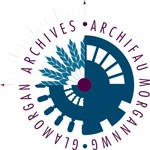Christmas Eve was always a very special day in the Glamorgan and Monmouthshire Infirmary, but 24 December 1883 was something out of the ordinary. It was the very first Christmas at the new hospital on Newport Road, Cardiff that we know today as the Cardiff Royal Infirmary. The list below was taken from the Hospital’s Annual Report for 1883 and details just some of the Christmas presents provided by local people for distribution to the patients.

Toys for children, knitted cuffs, three cases of oranges, crackers, fruits, nuts, biscuits, fancy goods, warm clothing, scrap books, illustrated papers, a pair of shoes, a parcel of Christmas books, handkerchiefs, Christmas letters and basket of fruit. [Abstract from Glamorgan and Monmouthshire Infirmary and Dispensary 47th Annual Report, p.11 (DHC 50)].
In each case the name of the provider was printed in the annual report, for the hospital was entirely dependent on donations. The number of patients on Christmas Eve was fairly low at 46 in a hospital built to cater for 120 inpatients at any one time. There was always a policy of reducing numbers in this period to enable as many as possible to enjoy the Christmas period with their families and to reduce the pressure on hospital staff. Numbers that Christmas, however, were lower than usual for, although opened on 20 September 1883, the hospital was still under construction and, in particular, the accommodation to be provided for the staff. As a result, for over 3 months, staff and patients had been housed together in the two two-storey blocks built as wards. Nevertheless the hospital staff, as always, went out of their way to make it a special day. The centre piece was a large Christmas tree lavishly decorated and surrounded by a mound of presents. In addition, the nursing staff had placed garlands and decorations around the walls of the wards and along the connecting stairways and corridors.
On Christmas Eve the patients and staff gathered in the Tredegar Ward to be welcomed by the Mayor of Cardiff, Mr R Bird, along with members of the hospital management committee. Entertainment was provided by Miss Anita Strina, the daughter of a Cardiff shipbroker, who played the harp and sang. Further songs were delivered by P Rhys Griffiths, the House Surgeon, and Mr Coleman, the Hospital’s Secretary. Then, under the watchful eye of the Matron, Miss Pratt, patients were invited to draw lots for the presents that surrounded the Christmas tree. The evening drew to a close with Matron expressing her thanks to all who had provided Christmas gifts and the donations towards the tree. In turn Mr Griffiths thanked Miss Pratt and her nurses for their work in making the evening such a special occasion. The following day, Christmas Day, after a morning service delivered by a local clergyman, there was a lunch of roast beef and plum pudding except, of course, for those unfortunate enough to be on a ‘special diet’ as part of their treatment.
As the first Christmas in the new building it was a very special occasion, despite the difficulties caused by the ongoing building work. It may well have been that the early move in September to the new buildings was prompted by the urgent need for a new and bigger hospital. However, there is no doubt that the income of £400 per annum to be provided by renting the old hospital building to the University College of South Wales and Monmouthshire for the 1883 autumn term was a factor in timing. It cannot have been the most comfortable of times, and it was to be another five months, May 1884, before the building was finally complete with its grand frontage on Glossop Road and grounds laid out by Lord Bute’s Head Gardener, Andrew Pettigrew.
Tony Peters, Glamorgan Archives Volunteer









